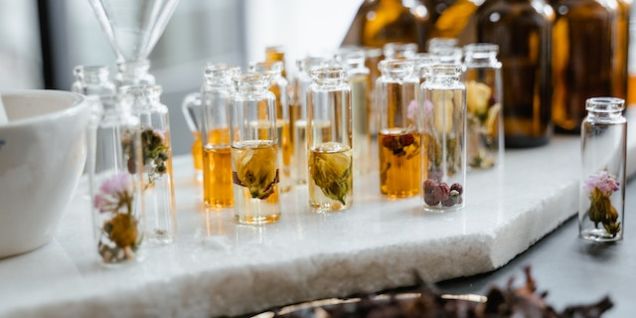Learn How To Make Your Own Perfume At Home


Perfume is one of the most popular and luxurious ways to smell good. It's also one of the oldest, with records dating back thousands of years in Egypt, Greece, and Rome. Both men and women used perfumes to mask unpleasant odors from their bodies and clothes.
Perfumes can be made at home using natural ingredients or purchased from a store or online retailer. When you make your own perfume at home, it allows you to personalize it based on your preferences for scent type (floral versus spicy) and fragrance strength (light vs heavy). You'll also save money by making your own perfume at home instead of buying them from stores that charge higher prices because large companies like Estee Lauder or Chanel mass-produce them.
Understanding the basics of perfume-making involves learning about the fragrance pyramid, which consists of top, middle, and base notes. Additionally, it's crucial to grasp the differences between perfume types such as eau de cologne, eau de toilette, and Eau de parfum. Finally, familiarize yourself with scent families like floral, oriental, woody, and fresh to create a well-rounded and appealing fragrance.
If you're just getting started with making your own perfume at home, there are a few tools and ingredients that will make the process much easier. You can find these items online or at any health food store.
The first step in creating your signature scent is identifying your preferred scent profile. This can be done by experimenting with different combinations of notes or by taking a quiz such as the one provided by The Perfume Society.
Once you've determined what kind of fragrance works best for you, it's time to start balancing the pyramid--the three main categories (top, middle, and base notes) that make up any perfume formula.
For Example:
Top notes: Aroma compounds that evaporate quickly when applied onto skin or clothing; they tend to be lighter than other ingredients in perfumes because they're designed to fade away within minutes after applying them to yourself or another person.
Middle notes: These are usually floral or fruity fragrances that linger longer than top notes but still don't last as long as base notes do; most people will find these scents pleasant but noticeable enough so as not to be too overpowering
Base notes: These are the foundation of perfume, providing depth and longevity. They include rich, earthy scents like amber, patchouli, and sandalwood and emerge as the fragrance dries.
Perfume recipes are simple, but they can be adapted to create a variety of scents that suit your individual taste. The following are some basic recipes for beginners:
Simple Perfume Recipe For Beginners:
Advanced Formulation For Experienced Creators:
Preparing Your Work Area
Measuring and Combining Your Ingredients
Testing Your Creation
Allowing Your Perfume To Mature
Storing Your Perfume
Labeling Your Perfume
Enjoying Your Creation
Your perfume is a personal statement. It's your scent, and it should be something that you enjoy wearing every day. So when it comes time to enjoy your creation, take some time to savor the experience!
READ MORE: Best New Perfumes To Fall In Love With This Year
Perfume making doesn't come naturally; learning how to do it well takes time and dedication. But once you get started, we guarantee your love for fragrances will grow exponentially as your skills improve. And who knows? Maybe one day, people will ask YOU for advice on making their perfumes at home!
Essential oils, ethyl alcohol, and distilled water.
Allow your perfume to mature for 1-2 weeks.
Store your perfume in a dark glass bottle, away from direct sunlight.
Related Post
Lip Fillers Before and After: A Detailed Guide
You may believe you've read everything about lip fillers. However, Lip Filler Before and After should be thoroughly understood if you're considering this cosmetic process.
Quick And Easy Hair Care Routine For Managing Fluffy Hair
Fluffy hair affects many people. Overvolume causes it. Hormones and genetics can cause this. It can be effectively managed and eliminated. How to get rid of and manage fluffy hair is covered here.
The Pros & Cons of Anti Eyebrow Piercings
People rarely have anti eyebrow piercings, making them difficult to learn about. You should get all the facts straight before you commit to this piercing, though, since it's such an obvious one.
Tips & Tricks For Maintaining Your Neck Beard
Take your time shaving around the beard just as you would when shaving your face. It takes time to shave properly, especially when it comes to pre- and post-shave care.
Popular
6 Affordable Makeup Organizers To Declutter Your Vanity
For the makeup lovers! Here are the best 6 Affordable Makeup Organizers To Declutter Your Vanity.
Look at the Stunning Debut of Alia Bhatt at the Met Gala 2023
Alia Bhatt Met Gala 2023 debut was a huge success, and she certainly made a mark with her stunning look. Now grab for more details here!
Crunches Vs. Sit-Ups: Which One Is Best For Your Abs?
Exercises that burn fat can help you lose weight .If you want to know Crunches Vs. Sit-ups: Which one is best for your Abs read below
Black Seed Oil Benefits For Hair and Skin
Black seed oil offers a wide range of benefits for hair and skin. Now get more information about black seed oil visit the blog!
